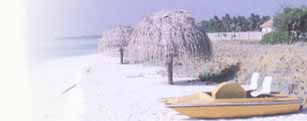| The
Golden Beach and the Shimmering Lagoons |
|
Perhaps
the charm of Lakshadweep islands lies in their remoteness. Far off
the beaten track, they attract no hordes of merry makers to its
shores, or perhaps it is the beauty of the islands densely covered
with coconut palms, and threaded by an unbroken line of creamy sand,
each island serenely set in a sea whose waters range from palest
aquamarine and turquoise to deepest sapphire and lapis lazuli. Yet
again , may be the unique charm of Lakshadweep lies in the fact that
each island, a tiny principality in itself, has existed from time
immemorial, with little influence from the outside world. |
|

|
|
REACHING THERE
The
Lakshadweep group of islands are well connected both by Air
and Sea. While Islands like Agatti & Bangaram can be reached by
Air, the other islands can be reached by ship from Kochi. The ship
offers different classes of accommodations. A/c First class with
two/four berth cabins & tourist class with A/c seating. The
vessels have all the facilities that go with a passenger vessel ,
namely video shows, cafeteria & snack bar, upper-deck airing
space , entertainment lounge, Doctor on call etc.
|
|
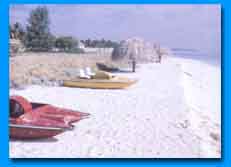
|
|
Whatever
the reason for Lakshadweep's magic. one fact is certain - it
is the big destination of tomorrow
Lakshadeep is an archipelago consisting of 12 atolls, 3 reefs and 5
submerged banks. there are 10 inhabited islands and 17 uninhabited
islands with a total geographical area of 32 sq. kms. It is located
between 8 degrees - 12 degree 13'North latitude and 71 degree -74
degree East longitude, 220 to 440 Kms. away from the coastal city of
Kochi in Kerala, in the emerald Arabian sea. |
|
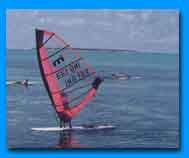
|
|
Climatic
conditions are similarto that of Kerala coast. Average rainfall is
1600mma year with the major share from thesouthwest monsoon. Almost
all islands experience tropical climate with temperature ranging
from 25 degrees c to 35 degrees c and humidity ranging from 70 -76
per cent during the most part of the year. March, April and May are
the hottest months of the year.
There is silence here, unbroken but for the cry of a seabird, or by
the soft paddle of a local canoe as it moves gently over the waves
the water is so clear that one can see the fish among the coral;
while snorkelling or deep sea diving, these waters come alive with
amazing clarity and colour! A polluting free, the only coral island
is the Rama Rajya of the great country of india |
|
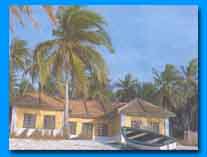
|
|
History |
|
|
|
Not
much is known of the early history of Lakshadweep. However, enough
evidence exists to piece together a history of the islands from the
7th century onwards. The people were converted to Islam under the
influence of Hazrat Ubaidullah who set off from Mecca after Prophet
Mohammed (S.A.S) appeared to him in a dream, commanding him to leave
for distant shores to propagate Islam. The ship on which Hazrat
Ubaidulla was sailing was wrecked and after drifting on a plank of
wood he reached the island of Amini where his mission met with
fierce opposition.
After many difficulties he was able to carry out his mission, and to
this day, the people of Lakshadweep follow Islam. Traces of the old
culture still linger however; despite the influence of Islam, caste
system still prevails based on occupation- landowners, sailors and
cultivators. Although Madrassas in all the islands impart religious
instruction to school going children, many individuals bear two
names. |
|

|
|
Culture |
|
|
|
Ethnically
the people of the islands are very similar to the people of Kerala
even their languages is the same except in Minicoy where Mahl is
spoken. As Muslims, they have conservative customs and traditions
and yet they are liberal in approach. 93% of the popultion are
indigenous Muslims. According to 1991 census, population is 51707.
History comes alive in folk ballads that women chant during their
house - hold chores. Events of the past - the arrival of
Hazrat Ubaidulla in Lakshadweep, the plunder of the islands by the
Portuguese, have been perpetuated by the balladeer.
Smiling and friendly people. Nobody is tip-minded. The place in the
world to go for a walk, with no dogs and no poisonous snakes either.
The people of Lakshadweep are often commended for their honesty. The
absence of crime in the islands is laudable. The most obvious
testimony to this is the profusion of gold ornaments worn by the
women - heavy ear rings and necklaces. The fact that very young
children are allowed to wander around alone wearing chunky jewellery
is a pointer to a way of life that one hopes will continue into the
future.The young men have some spirited folk dances. The women are
modest with colourful dress and wear their jewellery in safety. The
people of Minicoy have a good sense of colour, painting their
houses, furniture and boats in bright and tasteful combinations.
Seamen from Minicoy are to be found on merchant ship all over the
world. |
|
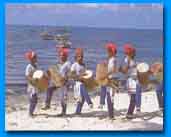

|
|
Tourism |
|
|
|
Tourism
in these islands is restricted so that their beautiful environment
is not damaged. As guests on these islands you will have the chance
to meet some of the friendliest people and, like them, stay in
cottages made of indigenous materials with their palm thatched
roofs. You will have the chance to commune with nature in virtual
solitude on a holiday that will be different from any other you've
even enjoyed. The Lakshadweep islands provide an experience that can
never fully be explained in words or captured on film.
To ensure that the way of life of the
islands is not disturbed by external influences, only four islands
have opened for domestic tourism and one Viz. Bangaram opened for
International Tourism. |
|

|
| KAVARATTI |
|
|
|
The
administrative capital, Kavaratti is the most developed of the
islands with the highest percentage of non-islanders as residents.
Fifty two mosques are spread out over the island, the most beautiful
being the Ujra mosque. A well, within its precincts, is believed to
contain water of curative powers. The Ujra mosque has an ornately
carved ceiling, said to have been carved from a piece of driftwood.
Kavaratti also has an aquarium with several colourful species of
fish.
There is a glass bottom boat for
viewing marine life and an array of remarkable coral formations that
provides a background to the lagoons and the islands within them.
Some Water Sports like Kayaking Canoeing and Snorkeling are
available for tourists. |
|
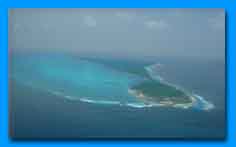
|
| KALPENI |
|
|
|
Kalpeni
has three uninhabited satellite islands, all surrounded by an
immense lagoon of spectacular beauty. Sunlight on the water causes
it to sparkle and flash like a million aquamarines. Koomel, the
gently curving bay where the tourist facilities are located,
directly overlooks Pitti and Thilakkam, two of the islands. Here you
can swim, reef walk, snorkel or use water sports equipment like
kayaks, and sail boats. Now the tourist facilities have been
augmented and tourists can stay on the island in privately managed
huts, depending on the package. This lagoon is specially rich in
coral life. |
|
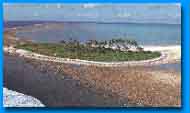
|
| KADMAT |
|
|
|
A
particularly fine lagoon, of even depth and an endless shoreline,
perfect for swimming, makes Kadmat a haven of solitude., The tourist
huts are situated some distance away from habitation, with only the
splash of the waves to break the silence. During the day, when the
beat of the overhead sun becomes too strong, the feathery network of
coconut palms provides a canopy throughout the island, through which
light dimly filters, green and cool. It is the only island with
lagoons on both eastern and western sides. A Water Sports Institute
providing water sports facilities has been set up in Kadmat.
Accommodation consists of AC and non AC tourist huts aesthetically
situated in the coconut palm groves on the beaches. The island is
becoming increasingly popular for honeymooners. As a testimony to
its Water Sports potential, a Scuba Diving Centre has been set up
there. |
|

|
| MINICOY |
|
|
|
Furthest
from Kavaratti island, 200 Km. away to the south and also nearer to
the Maldives, Minicoy has a lighthouse built by the British in 1885.
Visitors are allowed up, right to the very top. Words cannot do
justice to the incredible size of the lagoon, one of the largest in
Lakshadweep, the green of coconut trees, and the mirror-like surface
of an inland lake as it nestles in one corner of the island. Minicoy
has a culture very different from any other island - dress,
language, food, all differ. Minicoy has a cluster of 10 villages,
which are called Athiris, each presided over by a Moopan. A walk
through the winding lanes of the villages is an indication of the
culture here. Minicoy is renowned for its dance tradition: the lava
dance is performed on festive occasions. There is a tuna canning
factory - signifying its importance in tuna fishing and boat
building activity. Privately managed cottages have been built on the
isolated beaches and are available for tourists. |
|

|
| AGATTI |
|
|
|
Agatti
has one of the most beautiful lagoons in Lakshadweep. This is where
the airport is built. A virtual gateway of Lakshadweep, a 20 bed
tourist complex has been set up here. The island will shortly be
opened for tourists.
|
|

|
| BANGARAM |
|
|
|
There
is something indescribably romantic about the very notion of an
uninhabited island and Bangaram justifies that feeling. Tear-drop
shaped, it is encircled by a continuous halo of creamy sand. Like
all the other islands of Lakshadweep, luxuriant plantations of
coconut provide coolness even during the hottest part of the day.
There are three uninhabited islands in the same atoll consisting of
Tinnakara, Parali-I, Parali-II, each easily accessible by
outboarding, sailing rowing and for the athletic, by kayaking or
wind-surfing from Bangaram perfect for a day's outing. All the
islands share the same lagoon, an enormous bowl of turquoise blue.
At twilight, the setting sun, a ball of crimson in a flaming sky,
casts its reflection on the water, and with the ever present coconut
palms as a black silhouette, Bangaram is at the height of its
allure. That is the hour when every visitor promises himself another
visit someday.But that is not all. The warm, clear, deep waters of
the Indian Ocean with its myriad marine flora and fauna are an
irresistable invitation to the scuba diving fraternity of the world.
The exquisite coral formations including the black coral formations,
the large variety and number of coral fish-the angel, the clown, the
butterfly, the surgeon, the groupers, not to mention the abundance
of the awesome, but harmless sharks, mantarays, sting rays, moray
eels (morena) and turtles, make diving here an addictive experience,
enough to make impressive any diver's logbook with the stamp of the
Diving School at Bangaram. |
|
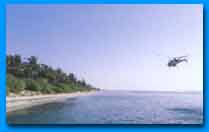
|
|
|
|
|
And
quite important too is the philosophy of preservation of marine life
in its state of indigenous purity, where the coral and the shell are
left undisturbed and the fish merely observed. The more venturesome,
however may espy a sleeping nurse-shark, as commonly seen as the
grey and the white tipped or play with a friendly turtle.
The Bangaram Island Resort is fast
becoming a by-word among the island hoppers of the world. Opened
only recently to foreign tourists the resort with its simple, but
attractive housing has already become a circled spot in the
brochures of tour operators and travel agencies all over. |
|

|
|
The
spell bound expanse of emerald isles, Lakshadweep studded in the
blue water of the Arabian sea unfolds another world in itself. The
panorama encompasses magnificent lagoons, sylvan sea shores, miles
of sun drenched sand and the enchantment of swaying palms. All these
harmonise to form a colourful kaleidoscope typical of an archipelago
paradise. This charming isolated destination has only 10 of its
islands inhabited. Of these five are open to tourists:
|
|
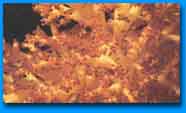
|
| FAUNA
AND FLORA |
|
|
|
The
flora of the islands include Banana, Vazha,(Musaparadisiaca),
Colocassia, Chambu (Colocassia antiquarum) Drumstic moringakkai (Moringa
Oleifera) , Bread Fruit, Chakka (Artocarpus incisa) wild almond (Terminalia
Catappa) which are grown extensively. Some of the shrub jungles
plant like Kanni (Scaevolakeeningil), Punna, (Calaphylluminophyllum),
Chavok(Casurina equisetifolia), Cheerani (Thespesia Populnea) are
unevenly grown throughout the island. Coconut, Thenga (Cacos
nucifera) is the only crop of economic importance in Lakshadweep.
These are found in different varieties such as Laccadive micro,
Laccadive ordinary, green dwarf etc. Two different varieties
of sea grass are seen adjacent to the beaches. They are known as
Thalassia hemprichin and Cymodocea isoetifolia. They prevent sea
erosion and movement of the beach sediments.
The
marine life of the sea is quite elaborate and difficult to condense.
The commonly seen vertebrates are cattle and poultry. Oceanic birds
generally found in Lakshadweep are Tharathasi (Sterna fuscata) and
Karifetu (Anous solidus). They are generally found in one of the
uninhabited islands known as PITTI. This island has been declared as
a bird sanctuary.
Molluscan forms are also important from the economic point of
the islands. The money cowrie (cypraea monita) are also found in
abundance in the shallow lagoons and reefs of the islands. Other
cypraeds found here are cypraca talpa and cyprea maculiferra. Among
crabs, the hermit crab is the most common. Colorful coral fish such
as parrot fish (Callyedon sordidus), Butterfly fish (Chaetodon
auriga), Surgeon fish (Acanthurus lineotus) are also found in
plenty.
|
|
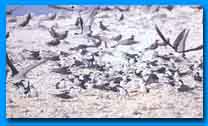
|
|
(Chaetodon
auriga) locally known as "Fakkikadia".(Anus solidus
piletus) locally known as "Karifettu".(Artocarpus Incise)
locally known as "Chakka" The predominance of women folk
in all walks of life is a peculiar feature of Minicoy. The husband
takes the wife's family name after marriage. All family affairs are
managed by the female of the house.
Most
males being the bread-winners of the family serve in international
ships as seamen. The famous traveller Marco Polo(1254-1324) in his
travelogue made a reference to Minicoy as the island of
females. The turkish traveller Ibnu Bathuta touched Minicoy while on
his way to Maldives and married two women and stayed there for one
month. In the village (Athiri) administration, the ladies have
an important role. The female Chief(Boduthatha) is the head of the
women's assembly who organizes Women's labour for common purposes in
the "Athiri" |
|
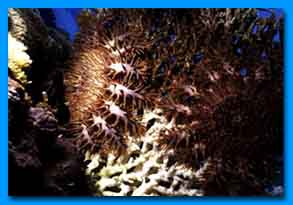 |
|
The
light house of the island is one of the oldest and was
constructed in 1885. You will be taken to the villages, tuna canning
factory, the light house and for a long drive through dense coconut
groves and winding village roads. The beaches have bathing huts and
change rooms; so swim and beach walk, Pedal boat, Kayak and Sail. We
provide these on hire. Tourist cottages and one 20 bedded tourist
home have been constructed for the staying tourists. This island is
part of Coral Reef and Swaying Palm packages. enjoying sea
breeze and moonlit beach. Water sports crafts like kayaks, pedal
boats, sailing yachts, skiing boats and glass bottomed boats
are available on hire. The scuba diving centre in the island has
become an attraction for water-sport enthusiasts. |
|
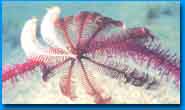
|
| Deep
in Sea |
|
|
|
It
is obvious that land animals and plants have not made these islands
popular with nature lovers; the real beauty and variety lies in
the underwater zone, just as it is to be found in the changing color
of the sky above.
The creator of all the underwater beauty is the polyp that is truly
the architect and engineer of the coral reef. It secretes a cup-like
calcareous skeleton into which it can withdraw. Multiplying by successive
budding, an intricate structure of polyp cups is eventually formed
and is attached to a submerged rock platform. The colony grows whenever
the depth is short enough for light to pierce, a condition, which
prevails in shallow lagoons.
Eventually reefs are formed and these enclose shallow saltwater
lakes called lagoons. Soon the decayed and dead coral is broken
into fragments and sediments of decaying organic matter, which,
along with droppings of birds, combine with it on the reef to give
a fertile soil.
Since the rate of nutrient turnover is high, the variety of animal
life that establishes itself in the atoll environment is indeed
vast. Coral reefs and lagoons shelter the most complex and organized
community of living creatures of the sea.
It is impossible to forget the sight of the
shoals of tiny but colorful fish darting in and out of coral branches
or languid anemones. Lakshadweep reefs abound in more than a thousand
species of fish, all dazzling in color and weird in pattern and
shape.
To heighten the sense of adventure of a skin diver, deadly rays
are often seen on the shallows of reef flats. These, along with
the poisonous stonefish, camouflage themselves so effectively on
coral ledges and rocks that they are almost impossible to make out.
Seashells are a constant source of delight for a visitor. The reef
flats are almost totally exposed except for shallow tide pools at
low tide. A trip to them is immediately rewarding: attached to rocks
or stones are the hydroids, sponges, corals and sea anemones. Trapped
between the tides, taking shelter under boulders or in shallow pools,
are bottom dwelling marine invertebrates like sea stars, sea urchins,
sand dollars and sea cucumbers.
|
|
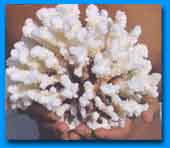
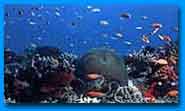
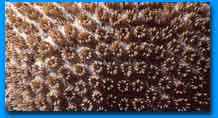

|
| DO's
and DON'TS |
|
|
|
Make
sure your reservation of tour before leaving your station. Carry
your special brand cigarettes, cosmetics etc. for use as only
ordinary varieties will be available on the islands. While in the
ship, a representative of SPORTS has been specially designated
to assist you. In case of any difficulty, please avail of his
services.
|
|
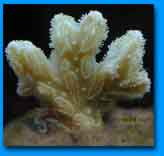 |
DONT'S
- Litter the land
or the water
- Pick any coral -
it is a punishable offence.
- There is
prohibition on all islands except Bangaram
- Take drugs or
narcotics - it is a punishable offence.
- Swim or sunbathe
nude-it is prohibited
- Go out of your
island lagoon without permission of the SPORTS authorities and a
proper escort - it can be risky
- Pluck tender
coconuts yourself. A fall can prove dangerous. The trees are
privately owned and unauthorized plucking of coconut is a
theft.
|
|

|
|
Download
Entry Rules ( Ms-word file zip format) |
|

